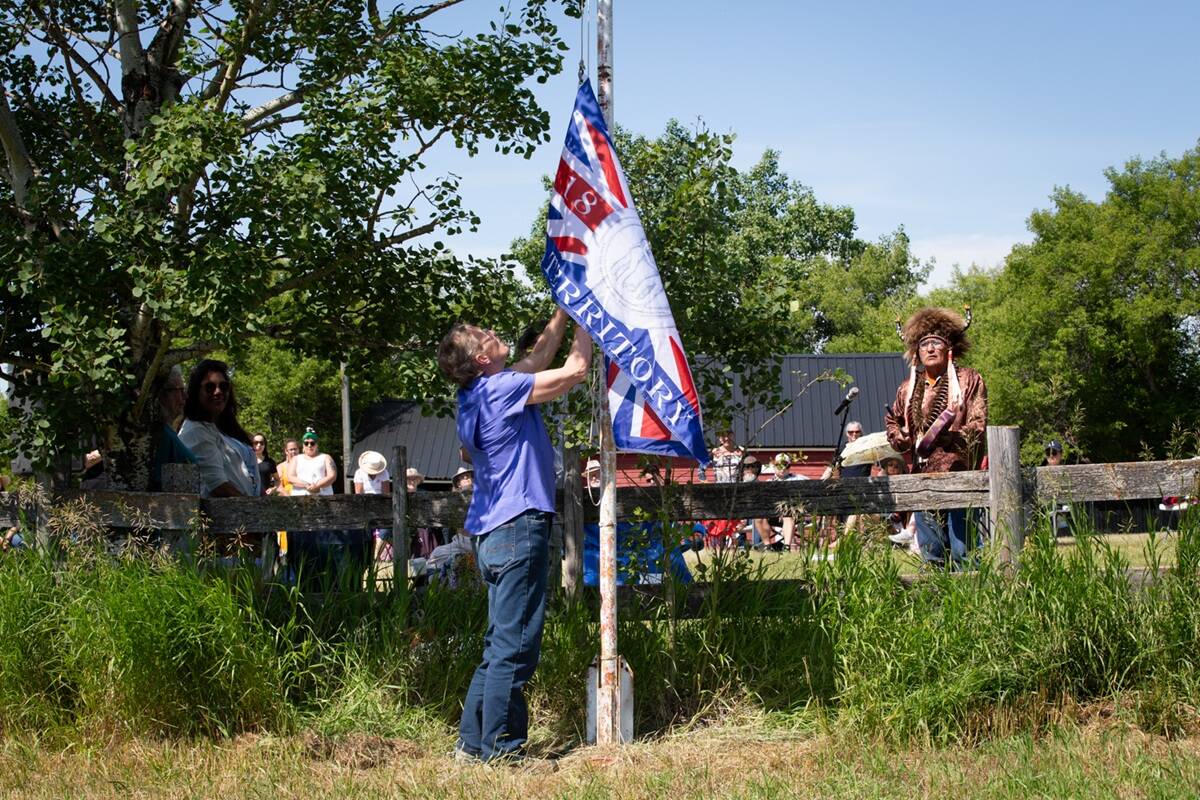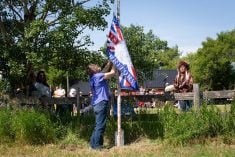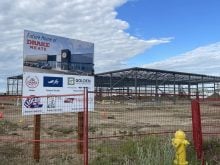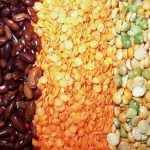A forward-looking strategic plan has underpinned Border Line Feeders’ growth through some of the most tumultuous years the beef industry has ever witnessed. The strength of the plan is its recognition that the feedlot business is as much about people — dedicated employees, satisfied customers and community support — as it is about feeding cattle.
No doubt, the company knows how to finish out calves, too. A 97 per cent customer retention rate is proof enough of that. “Our customers are from all over Canada from Alberta to Quebec,” says manager Ryan Thompson. “We have the local guys who retain ownership of their calves and customers from outside of the region who purchase and place calves with us. We do buy cattle once in a while — maybe during the summer months when it’s slower.”
Read Also

Treaty Land Sharing Network expands reach in Saskatchewan and Alberta
The Treaty Land Sharing Network, which connects land holders with First Nations and Metis people, has expanded since it began in 2018
The feedlot is a first for the region. Like a number of Saskatchewan’s new feedlots, Border Line Feeders was founded through public share offerings around the turn of the century as an economic development initiative to create employment and bolster farm income by feeding calves at home rather than shipping them and the barley to Alberta.
It is owned and operated by 400 shareholders, most of whom live within an hour of Ceylon. The first share offering was in 2000 and Border Line Feeders was incorporated in 2001, built in 2004, and went into operation with a 7,300-head capacity in October, 2005. A 2007 expansion increased capacity to 12,000 head. The final expansion to the permitted 20,000 head is expected in the near future.
One of its strengths is its location between the ranches of the rolling Missouri Coteau to the southwest and the grain-producing region of the Regina Plains to the north and east. Wet distillers grain and distillers syrup from the ethanol plant at nearby Weyburn have become an important feed source to reduce the cost of gain. Located about a half an hour north of a 24-hour border station, proximity to the U.S. packing plants is another drawing card.
Markets dictate whether the finished stock will be shipped to the U.S., Alberta, or Ontario, Thompson adds. Larger customers do their own marketing, while those with fewer cattle tend to prefer to leave it up to the feedlot to deal with the packers. By sorting and managing the calves in like groups, they can capture the advantage of shipping uniform loads of cattle.
Others have noticed their success. Border Line Feeders has been a finalist or winner in various categories of the Award for Business Excellence (ABEX) program every year since 2006. The ABEX awards are sponsored annually by the Saskatchewan Chamber of Commerce to recognize outstanding business achievements. This year, Border Line Feeders was a finalist in two categories: customer service and community involvement. The awards were handed out at a gala event in Regina on October 30, after this issue went to press.
Customer service
As a custom feeder, Border Line Feeders will accommodate almost all customer requests including individually tailored feeding and animal health programs,” explains Dawn Hillrud. After working with the group in an administrative role during the founding year, Hillrud, who has a degree in human resources, joined the staff in 2006 to fill that role as well as that of cattle manager.
Some of the most common requests for tailored programs have been finishing calves for Canada Gold, which requires a special vaccination protocol. There have been requests to not use growth implants, particularly for potential replacement heifers, in which case they tweak the ration so that the heifers don’t become overly fat.
The feedlot is situated on 160 acres of land, leaving space in the adjoining pastures to custom winter-bred cows up until calving.
Animal health
The animal health program is monitored by veterinarians from the Prairie Animal Health Centre but health technician, Taras Lagun, handles the day-to-day animal health-care needs. He’s a veterinarian from Ukraine who joined the staff in January 2009 under a two-year work visa which has since been extended to January 2013.
A chute-side computer is used to tie all of the health information to the animals’ feedlot identification number and the RFID tag number for traceability, which has become a priority for the feedlot. They are also certified with the Verified Beef Production program.
In the main barn they’ve installed a double chute leading from the crowding tub to the single chute just before the headgate. Hillrud says this design lets animals move up in pairs and has worked great to keep the line moving when processing cattle. Geothermal heating in the barn and the main shop is another innovation that has helped keep a lid on energy costs.
A small treatment barn and pen were located on the west side of the feedlot so animals in that area can be looked after without having to make the long trek to the main barn. It also serves as a backup treatment facility at times when the main barn is being used to process cattle.
Feed program
Thompson brings a strong background in animal nutrition to his position. Rolled barley, barley silage, wet distillers grain and distillers syrup comprise the typical ration. Cattle are fed twice a day with the feed truck making two passes up and down the feed bunks so they are filled evenly from end to end. This is done to ensure that each animal gets its fair share of the ration since they tend to return to the same spot at the bunk each time they eat.
The feedlot does generate individual animal performance records at a customer’s request. Customers pay per pound of gain plus yardage, or based on a cost-plus basis, which includes yardage, feed, health and bedding.
Most of the grain is purchased from local farmers, but they also buy from main line companies when the price is right or when weather conditions make it tough for farmers to deliver.
Hay for starter rations and straw for bedding twice a week during cold and wet weather is all purchased locally. The excessive rainfall this summer was a boon for forage production, but put a damper on seeding operations in the spring and crop growth during the summer. That’s created a twist whereby the offering price for straw was higher than that for good-quality hay in October.
The feedlot grows a bit of its own silage on site, but most of it is contracted out to local farmers and brought in by custom silage outfits. This year they grew silage corn for the first time and, despite the cantankerous growing season, the crop yielded 12 tonnes per acre. That compares with a long-term area average of about seven tonnes for barley silage.
Thompson chose one of the newer corn varieties adapted to the shorter growing season on the Prairies. Wet weather delayed seeding to the limit as it was all in the ground by June 23 and touched by the first frost in mid- September. Cob production, which accounts for the bulk of the dry matter and energy content, was phenomenal even though the excess moisture promoted the growth of a second cob on each stalk. The ideal is to get one large, full cob per stalk.
Community involvement
Border Line Feeders’ community, as defined by their strategic plan, is found 100 kilometres around the feedlot. Within that border it is a regular supporter of amateur sports, charities and 4-H clubs and offers a future leader scholarship.
But their sense of community involvement goes a couple of steps beyond the usual support. Under their staff volunteer program, employees who see a need in the community are encouraged to undertake projects and are paid their regular wage if it requires time away from work. As just one example, they painted the cemetery fence.
Border Line Feeders also rolled out a community investment program in 2008 that accepts applications for projects that will make a significant difference to the well-being of the community. The Radville Community Curling Club was the first project. Funds were put up to renovate the facility, which was renamed Border Line Feeders Place. The first annual Border Line Feeders Bonspiel, with additional sponsorship from Novartis and Prairie Animal Health Centres, was held in February, raising additional funds to support the club’s sustainability.
The Pangman School Community Council had renovated the school playground and required assistance to pay off the balance.
Staffing solutions
The company’s growing reputation as a good corporate citizen has made it easier for them to attract and hold on to good employees. They offer a full benefit package including bonuses and a work-life balance plan to encourage participation in community and physical activities.
The feedlot employs about 13 people, fewer during the slow summer months and more during the winter. Most of the seasonal staff are local farmers. About half of the employees are local and the remainder are people who have moved to the area for the job opportunity.
Border Line Feeders provides an on-site transition house for minimal rent on a first-come-first-serve basis for any employee who needs accommodations while looking for permanent housing. It accommodates about three people.
Hillrud has been working with a private immigration consultant in Canada to locate and hire employees from Ukraine. The consultant recommended looking to Ukraine because of the skilled labour force there. The applicants must have enough knowledge of the English language to be able to conduct interviews over the phone.
So far, they have been fortunate to have Lagun join the staff, however, a second employee from Ukraine, Yuri, faced a tough decision to return home when complications arose surrounding his wife’s application to join him in Canada. Hillrud has set the paperwork in motion to bring two more Ukrainian workers to the feedlot this year.
The Canadian government issues the visa for one or two years — you never know. It depends on the labour situation at the time the Immigration Department approves the application. As soon as the employee arrives, he or she can begin the application process for permanent residency.
The orientation period can take a little longer because of the communication differences but the first employee becomes a valuable asset in training future employees who arrive from the home country.
“They are so willing to learn and work and so appreciative of everything we have in Canada. Unemployment plans, pension plans and paid holiday time are unheard of in Ukraine,” Hillrud says. “Their ultimate goal is to become a resident of Canada and to be successful they need a good reference from an employer.”
Aside from the paperwork, it does take some special preparation to bring in foreign workers. Border Line Feeders arranges for a furnished apartment, stocks the shelves with groceries, pays the first month’s rent, arranges transportation anywhere the employee may need to go for the first while, and helps out with anything else they need to get settled.
“You have to realize that these people give up everything they have in their home country for the opportunity to come to Canada. They have to pay the immigration consultant and their own airfare. When they arrive all they have is a bit of spare cash in their pocket,” Hillrud explains. “You can just imagine the stress they are under leaving their loved ones behind and coming to a new country. I don’t think we would have been successful if we hadn’t helped out.”
With some experience behind her, Hillrud feels she is ready to tackle it on her own, but definitely recommends working with an immigration consultant to get started. Most provincial governments have immigration programs to help bring in workers from overseas.
Cleaning Up
If not for the fall colours and combines at work in the fields in late September, the warm breeze and bustle of activity at Border Line Feeders could have fooled one into thinking it was July. Custom silage and pen-cleaning crews were hard at work making up for lost time due to the continuous rain this summer. The first calves of the fall run were scheduled to arrive that weekend.
An uncommon sight was the track hoe repairing the slope of the pens, which had been punched out in the mud throughout the summer. When cattle are in wet pens every hoof-print holds more water, adding to the problem, explains feedlot manager Ryan Thompson. Normally, the slope of the pens and lanes carries excess water to a natural retention pond at the far end of the feedlot so that none of the run-off leaves the site. The pond might have a couple of feet of water in it at the deepest point on a year with normal precipitation — this year, it’s been a haven for waterfowl.
Fortunately, Border Line Feeders had pen space available to rotate cattle into somewhat drier pens as the rainy days wore on. Unfortunately, that means a lot of pens need to be repaired.
The Saskatchewan Cattlemen’s Association (SCA) estimates it will cost an average of $25.44 per head to repair the damage to feedlots due to the excessive rainfall, says Thompson, who is the association’s vice-chairman. Businesses with more than $2 million in gross sales aren’t eligible for assistance under the Saskatchewan government’s provincial disaster program. There are worries that the situation will result in a loss of some of the feeding capacity the province has built up in recent years if some of the smaller and older feedlots decide to shut down their operations.
A delegation from the SCA travelled to Ottawa in September to explain the situation to members of Parliament, including Agricultural Minister Gerry Ritz. Other topics of discussion were flooded hay and pasture land, the need for a cattle price insurance program and forage insurance structured similar to crop insurance, international trade issues (COOL, Korea, the European Union) as well as concerns about the closure of Saskatchewan’s only federally inspected beef plant.
It’s been a rough five years in one way or another on almost all fronts in the cattle business since Thompson became the manager at Border Line Feeders in the fall of 2005. Though issues linger and one never knows what the weather will bring, he has a good feeling that the favourable supply- demand outlook for beef has put the Canadian industry in place where there is finally a light at the end of the tunnel.
















